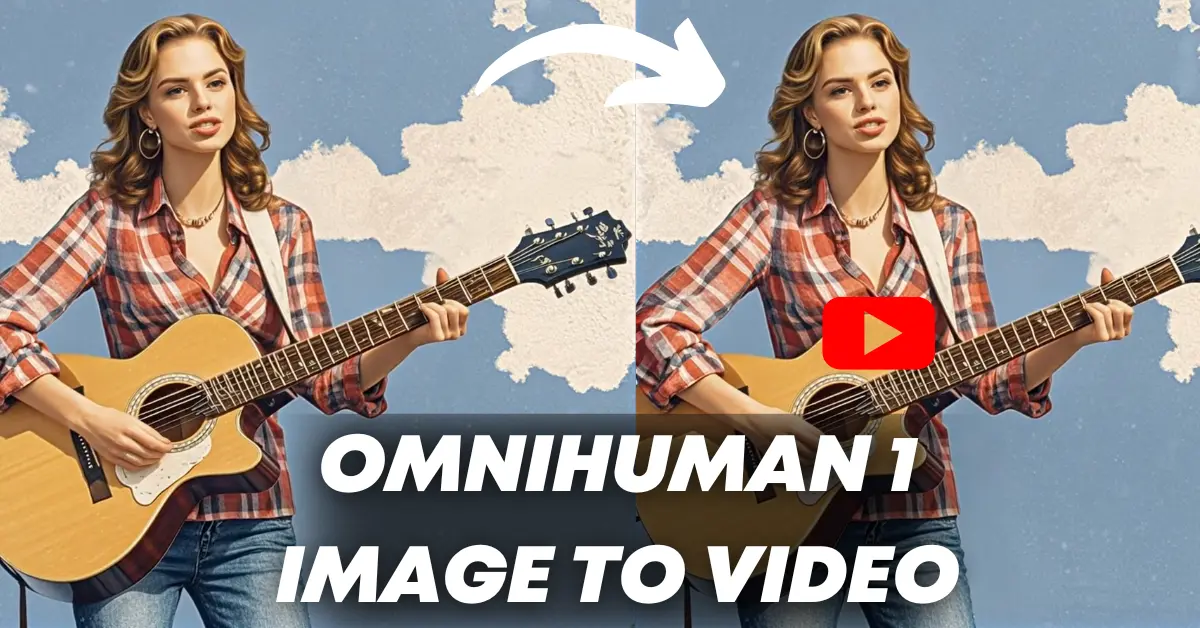OmniHuman: Turn Any Image or Audio into Realistic Videos

Introduction
You can convert your images to videos, creating realistic human videos with just a photo and a simple audio clip. It might sound like something out of science fiction, but it's now a reality.
Meet OmniHuman, an AI model that is changing the way human video generation works. In this article, I will take you through how OmniHuman functions, what makes it unique, and how it is pushing AI-powered animation to new heights.
What is OmniHuman?
Developed by researchers at ByteDance, OmniHuman is an AI framework designed to generate incredibly realistic human videos from just a single image and an emotion signal like audio or video. ByteDance has been pioneering AI video generation with tools like Seedance AI and Goku AI.
It works with various types of images, including portraits, half-body shots, and full-body images. The results include:
- Natural movements
- Realistic gestures
- High attention to detail
But what makes OmniHuman different from other models? Before we go deeper, let me know in the comments what you think about this new technology. Also, consider liking and subscribing if you find OmniHuman exciting for the future of video generation.
How OmniHuman Works
At its core, OmniHuman is a multi-modality conditioned human video generation model. This means it can take different types of inputs, such as an image and an audio clip, and combine them to create a realistic video.
Step-by-Step Process
1. Input
- Start with a single image of a person. It could be a photo of yourself, a celebrity, or even a cartoon character.
- Add a motion signal, such as an audio clip of someone singing or talking.
2. Processing
- OmniHuman uses a technique called multi-modality motion conditioning.
- This technique allows the model to understand and translate motion signals into realistic human movements.
- For example, if the audio is a song, the model will generate gestures and facial expressions that match the rhythm and style of the music.
3. Output
- The result is a high-quality video where the person in the image appears to be singing, talking, or performing the actions dictated by the motion signal.
- OmniHuman excels at handling weak signals, such as audio-only input, and still producing high-quality, realistic results.
- It is trained on diverse data, allowing it to scale up and perform better than previous methods that struggled with limited high-quality data.
Examples of OmniHuman in Action
Singing
OmniHuman can create dynamic singing videos. Whether it’s an opera performance or a pop song, the model captures the nuances of the music and translates them into natural body movements and facial expressions.
- Gestures match the rhythm of the song.
- Facial expressions align with the mood of the music.
Talking
OmniHuman excels at:
- Lip-syncing accuracy
- Generating realistic talking avatars
- Creating videos in various aspect ratios, making it suitable for different content formats
It can generate highly realistic talking avatars that feel almost human, making it useful for virtual influencers, educational content, and entertainment.
Cartoons and Anime
OmniHuman isn't limited to human characters, similar to how ByteDance's X-Portrait works with anime and cartoons. It can animate:
- Cartoons
- Animals
- Artificial objects
By adapting the motion to match the unique characteristics of each style, it becomes a powerful tool for animated movies and interactive gaming.
Portrait and Landscape Videos
OmniHuman works with:
- Portrait images
- Half-body shots
Even in close-up scenarios, the model captures fine details like subtle smiles and dramatic gestures.
Video Inputs and Motion Control
OmniHuman can also use video inputs as motion signals. This allows it to:
- Mimic specific actions from a reference video
- Generate videos where a person in a still image performs a dance or other movements from a different video
For even greater control, you can combine audio and video signals to animate specific body parts, providing a level of flexibility that was previously unavailable in human animation models.
Why This Matters
OmniHuman has the potential to impact multiple industries, including:
- Entertainment: AI-generated actors for films and music videos
- Education: Bringing historical figures to life in classrooms
- Virtual Communication: Personalized avatars for online meetings
- Healthcare: Therapeutic animations for patients
- Retail: Creating personalized shopping experiences
Can You Try OmniHuman?
Currently, OmniHuman is still in the research phase. The results seen in this article are based on the work described in research papers. The team has shared demos on their GitHub page and has mentioned that the code might be released soon.
While OmniHuman isn't publicly available yet, it provides an exciting glimpse into the future of AI-powered human animation. For a deeper analysis of its capabilities, check out our comprehensive OmniHuman review. Keep an eye on their GitHub page for updates—you might get a chance to experiment with it soon.
Conclusion
OmniHuman is pushing AI-driven video generation to a new level. From realistic singing and talking avatars to animated cartoons and flexible motion control, it offers endless creative possibilities. As researchers continue to refine the technology, we can expect even more impressive developments in the near future.